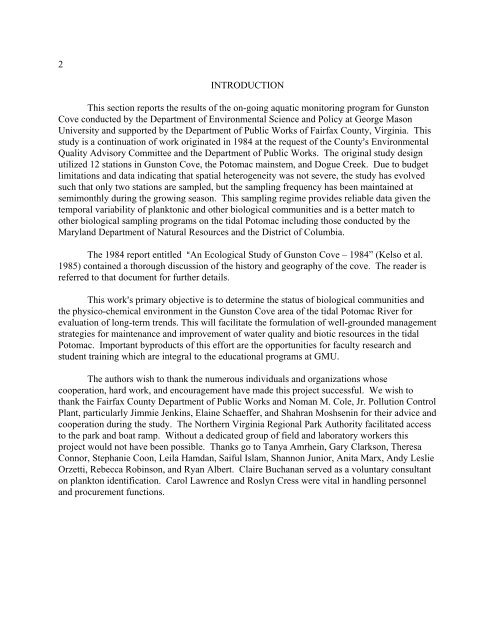NEW: Annual Report - George Mason University
NEW: Annual Report - George Mason University
NEW: Annual Report - George Mason University
You also want an ePaper? Increase the reach of your titles
YUMPU automatically turns print PDFs into web optimized ePapers that Google loves.
2<br />
INTRODUCTION<br />
This section reports the results of the on-going aquatic monitoring program for Gunston<br />
Cove conducted by the Department of Environmental Science and Policy at <strong>George</strong> <strong>Mason</strong><br />
<strong>University</strong> and supported by the Department of Public Works of Fairfax County, Virginia. This<br />
study is a continuation of work originated in 1984 at the request of the County=s Environmental<br />
Quality Advisory Committee and the Department of Public Works. The original study design<br />
utilized 12 stations in Gunston Cove, the Potomac mainstem, and Dogue Creek. Due to budget<br />
limitations and data indicating that spatial heterogeneity was not severe, the study has evolved<br />
such that only two stations are sampled, but the sampling frequency has been maintained at<br />
semimonthly during the growing season. This sampling regime provides reliable data given the<br />
temporal variability of planktonic and other biological communities and is a better match to<br />
other biological sampling programs on the tidal Potomac including those conducted by the<br />
Maryland Department of Natural Resources and the District of Columbia.<br />
The 1984 report entitled AAn Ecological Study of Gunston Cove – 1984” (Kelso et al.<br />
1985) contained a thorough discussion of the history and geography of the cove. The reader is<br />
referred to that document for further details.<br />
This work=s primary objective is to determine the status of biological communities and<br />
the physico-chemical environment in the Gunston Cove area of the tidal Potomac River for<br />
evaluation of long-term trends. This will facilitate the formulation of well-grounded management<br />
strategies for maintenance and improvement of water quality and biotic resources in the tidal<br />
Potomac. Important byproducts of this effort are the opportunities for faculty research and<br />
student training which are integral to the educational programs at GMU.<br />
The authors wish to thank the numerous individuals and organizations whose<br />
cooperation, hard work, and encouragement have made this project successful. We wish to<br />
thank the Fairfax County Department of Public Works and Noman M. Cole, Jr. Pollution Control<br />
Plant, particularly Jimmie Jenkins, Elaine Schaeffer, and Shahran Moshsenin for their advice and<br />
cooperation during the study. The Northern Virginia Regional Park Authority facilitated access<br />
to the park and boat ramp. Without a dedicated group of field and laboratory workers this<br />
project would not have been possible. Thanks go to Tanya Amrhein, Gary Clarkson, Theresa<br />
Connor, Stephanie Coon, Leila Hamdan, Saiful Islam, Shannon Junior, Anita Marx, Andy Leslie<br />
Orzetti, Rebecca Robinson, and Ryan Albert. Claire Buchanan served as a voluntary consultant<br />
on plankton identification. Carol Lawrence and Roslyn Cress were vital in handling personnel<br />
and procurement functions.
















